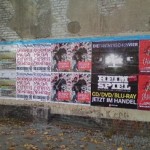Here I am, ears’ dropping to a conversation that takes place in the market. A woman who sells chestnuts tells the young man patiently waiting for the chestnuts to roast that she too just returned from Italy. She goes on explaining that he would better go visit the modern art museum.
The town has two modern art museums which she really likes, but the one behind the railway station is by far the one she likes best. She is rather short, wears a fur hat and every other accessory you may imagine a woman like her would wear. They speak in Italian. I mean they are both Italians and have discovered this by chance. The questions one hears when people meet a fellow countryman abroad revolve around subjects such as where from, how comes, what about the children as they try to find out more about the other person’s story – yet these two people speak about modern art museums. So now you will better understand my indiscretion and ears’ dropping: the subject of the conversation, you will agree, hardly matched the surroundings – that is the market, its veggies and fish, sausages and whatever else the market had on offer. Oh, I did not mention the one small detail that renders the above story credible: it happened in Berlin, a city where culture meets people with full speed and a lot of horse power, where information, education, and performances abound to the level of inflation. Berlin looks very much like a city ruled by fourth-grade economy just as text books describe it: a city in which the vast majority of people produce and consume cultural goods and even art – a money-making activity like any other industry – and the money thus made bring about development, social balance, and welfare.
The city as I discovered it during this recent visit plays perfect host to all contemporary artists, a high percentage of whom have actually moved here from all four corners of the world. To give you a clearer picture let me quote some of the figures that were mentioned – indeed well above any average I know of: 70 new exhibitions open every evening; 2000 exhibitions run in parallel every week; there are literally thousands of galleries, some hundred museums or so, hundreds of concerts every evening, not to mention all the theatre and opera performances, the best libraries you can imagine, top world-famous universities and research institutes (of which Max Planck is only the most renowned). Such bizarre statistics make it rather normal that market vendors talk about modern art and send you straight from the market to the museum. Well, perhaps.
Although in hard economic terms this is not yet sustainable – or at least this is what people gossip – I would bet on what is going on in the city: for Berlin is more than a city, it is a contemporary myth. A mythical city in which money and art converge – but how much can the city stock, what happens to the loads of creativity concentrated here along the high numbers of extremely independent people? Surely Berlin enforces one of most liberal, daring, and experimental policies around the globe. On the other hand I thought it was the dream of every politician to groom such a democratic, open, intelligent, and cultivated society; and in my mind I thought the mix between politics and aesthetics, between politics and beauty to put it bluntly, must be fun; to manage such mix would be nothing short of another form of art. I speculate, hence I idealize; this is not the case for sure since one collects money from all citizens and invests them in alternative art and poetry evenings.
So we are speaking of 2000 exhibitions… I seem to have developed an obsession for this figure which speaks for itself, needs no explanation, no comparison: it is simply mind- boggling.
Getting back to our own figures and statistics I find it very chic here in Bucharest where the situation is just the opposite. We too have an expressive set of figures, albeit the reverse: one parking lot built in twenty years, one museum of contemporary art, just a few kilometers of motor-road, a few more of rail road, one new park, a.s.o. Such figures fully agree with the low numbers of visionary politicians, credible financiers, or valid laws. So when it comes to art and the city, we too are fully compliant with such statistics. Faced with heritage or city outlook management, our politicians, the administration and of course, the body of practicing architects, can hardly meet the demands – rather all of them would over-compromise, the number of decent recoveries being kept to a minimum. We close ranks with all those who fight to preserve architectural values and certainly, a representative share of Romanian intelligentsia does take a stand against the brutal approach to old and beautiful houses. So far-so good, but is it not high time we also turned our eyes to the massive ugliness of so many a block districts around which our urbanity revolves? Yet the subject meets with little sympathy: when it comes to understanding the value of block-type architecture and block districts as a repository of energy – or rather the genuine frustration here gathered – dialogue remains suspended somewhere in mid-air. Had someone been interested in developing a genuine urban policy, all cosmetic embellishments and colourful flower beds should be left aside. Ugliness is so massive and real problems so abundant that one can easily understand why no one is interested in the subject; it is nevertheless fascinating to see how politics and aesthetics could join hands in a game of higher stakes. This is perhaps where “the new black” comes to prominence, a fascination bordering on artistic emotion face to face with so unpleasant a reality.
Photo: Constantin Goagea
Translation: Codruta Cruceanu


